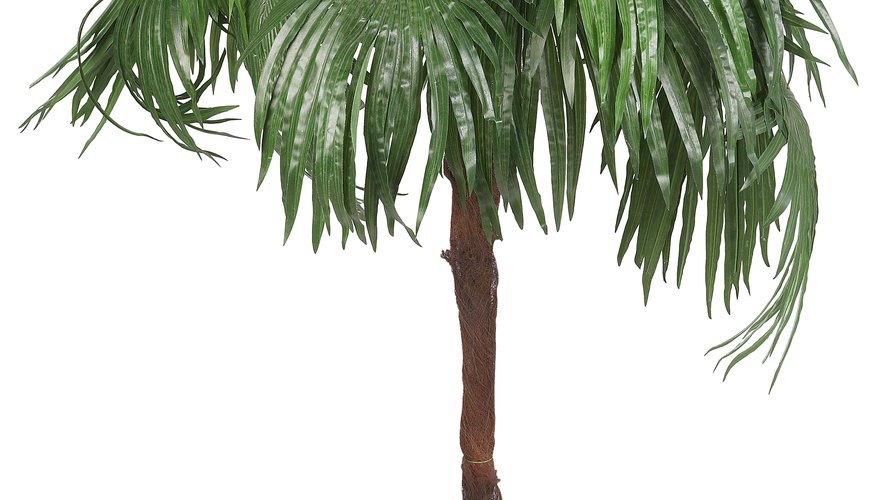As interior architectural specimen plants, palms are hard to beat. When unsightly yellow leaves occur, first determine the cause. Several conditions cause yellowing leaves on palm plants, but fortunately, proper placement, care and nutrition corrects most problems. Different palm species have different requirements, so become familiar with the needs of your plant. Examine your plant for signs of yellowing every time you water. Quick attention to yellowing leaves leads to faster recovery.
Light
Palm leaves turn yellow when the plant receives too much light. Some palms, such as date palms, European fan palms and kentia palms like a few hours of sunlight each day, but many prefer bright indirect or florescent light and should never receive direct sunlight. If the leaves turn pale green or yellow, reduce the amount of light. Palms like to spend time outdoors in summer. Place them in a shady outdoor location, protected from direct sunlight.
- Palm leaves turn yellow when the plant receives too much light.
- Some palms, such as date palms, European fan palms and kentia palms like a few hours of sunlight each day, but many prefer bright indirect or florescent light and should never receive direct sunlight.
Iron deficiency
Iron deficiency causes a yellowing condition called chlorosis. Adding iron fertiliser to the soil helps the leaves return to their natural colour, but this isn't a long-term solution. The problem is usually caused by poor soil aeration or planting the palm too deeply, which prevents the plant from absorbing available iron. As potting soil ages and degrades, there is less air between the particles of soil. For a long-term solution, repot the palm using fresh potting soil. When you repot, raise the level of the plant's crown in the soil if it is planted too deep.
- Iron deficiency causes a yellowing condition called chlorosis.
- For a long-term solution, repot the palm using fresh potting soil.
Nutrient deficiency
Palm plants are sensitive to nutrient deficiencies, particularly deficiencies of potassium, magnesium or manganese. Yellowing caused by nutrient deficiencies begins as spots or streaks on the leaves. Use a micronutrient spray for quick relief. For a long-term solution, use a fertiliser that contains potassium and micronutrients. Add an inch of good compost to the top of the potting soil, and occasionally add a pinch of Epsom salts to the water to provide magnesium. Each spring, sprinkle 90 g (1/2 cup) of compost on the top of the soil to provide additional micronutrients.
- Palm plants are sensitive to nutrient deficiencies, particularly deficiencies of potassium, magnesium or manganese.
- For a long-term solution, use a fertiliser that contains potassium and micronutrients.
Spider mites
Spider mites suck the sap from palm leaves, leaving small yellow spots. The mites are hard to see, but their webbing and the spots they leave behind are enough to let you know they are there. Spider mites love a dry, dusty palm, so use a soft cloth to remove dust and mist the plants daily. Palms enjoy an occasional lukewarm shower but spider mites don't, so make showers a part of your regular care routine. Some palms are sensitive to insecticidal soaps. Test the product on an inconspicuous part of the plant before treating the whole plant. If your palm tolerates the spray, use it at five-day intervals until the spider mites are under control.
- Spider mites suck the sap from palm leaves, leaving small yellow spots.
- Spider mites love a dry, dusty palm, so use a soft cloth to remove dust and mist the plants daily.
